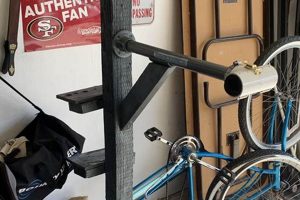The concept involves creating a temporary or semi-permanent structure, often for events or gatherings, where food and beverages are sold. These structures are constructed using readily available materials and customized according to specific needs and aesthetic preferences. A backyard movie night, a community sporting event, or a school fundraiser could all benefit from such a setup.
This endeavor offers several advantages, including cost-effectiveness compared to renting a pre-made stand. It promotes resourcefulness and creativity, allowing for unique and personalized designs. Historically, the establishment of similar refreshment stations dates back to markets and fairs, evolving with contemporary needs and demonstrating the enduring appeal of accessible on-site refreshments.
Subsequent sections will explore practical construction considerations, material selection guidelines, and strategies for optimizing operational efficiency within such a setup. The focus will be on providing clear, actionable advice applicable across various event types and budgets.
DIY Concession Stand Construction
The following recommendations aim to guide the efficient and effective construction of a refreshment station. Adherence to these suggestions enhances functionality and promotes a safe environment.
Tip 1: Secure Necessary Permits: Prior to construction, verify local regulations regarding temporary structures and food sales. Failure to comply may result in fines or mandatory dismantling.
Tip 2: Develop a Detailed Plan: Create a schematic outlining dimensions, material lists, and assembly procedures. A well-defined plan reduces errors and minimizes material waste.
Tip 3: Prioritize Food Safety: Incorporate features such as hand-washing stations, food-safe surfaces, and temperature-controlled storage to prevent contamination. Adherence to food safety standards is paramount.
Tip 4: Ensure Structural Stability: Utilize durable materials and robust construction techniques to withstand weather conditions and prevent collapse. Reinforce joints and connections for added stability.
Tip 5: Optimize Workflow: Design the layout to facilitate efficient movement and minimize congestion. Clearly delineate preparation, service, and payment areas.
Tip 6: Provide Adequate Lighting: Install sufficient lighting to ensure visibility and prevent accidents, particularly during evening events. Consider both ambient and task lighting.
Tip 7: Incorporate Weather Protection: Implement measures to shield occupants and equipment from inclement weather. A sturdy roof or awning is essential.
Adherence to these tips ensures a functional, safe, and aesthetically pleasing refreshment station. Careful planning and execution maximize the value and impact of this resourceful endeavor.
The subsequent section will provide detailed guidance on material selection, providing insights into cost-effective and durable options.
1. Affordability
Affordability serves as a critical determinant in the viability and accessibility of self-constructed refreshment stations. The economic advantage derived from a do-it-yourself approach frequently drives its adoption, offering a cost-effective alternative to commercially produced or rented units. This consideration impacts material selection, design complexity, and operational scale.
- Material Sourcing and Cost Reduction
The selection of readily available, low-cost materials directly impacts the overall affordability. Repurposed lumber, reclaimed pallets, and discounted hardware offer significant savings compared to purchasing new materials. Careful planning and resourcefulness can minimize expenditures without compromising structural integrity or functionality. For instance, utilizing discarded doors as countertop surfaces or repurposing shipping containers as structural elements demonstrates resourceful cost reduction.
- Labor and Skill Investment
The primary investment in a self-constructed station is often time and labor rather than capital. The skills required for construction, ranging from basic carpentry to electrical wiring, influence the overall cost. While professional assistance may be necessary for certain aspects, leveraging personal skills and enlisting volunteer labor from community members or friends reduces expenses. Accurate assessment of skill levels is essential to prevent errors and ensure safe construction practices.
- Long-Term Operational Savings
Affordability extends beyond the initial construction phase to encompass long-term operational costs. Designing for energy efficiency, utilizing durable materials that require minimal maintenance, and implementing waste reduction strategies contribute to sustained savings. For example, installing LED lighting, opting for weather-resistant paints, and incorporating recycling bins lower operating expenses over the lifespan of the station.
- Scalability and Adaptability to Budget Constraints
The modular nature of many self-constructed stations allows for phased development aligned with budget limitations. Initial construction may focus on essential components, with subsequent additions and enhancements implemented as resources become available. This scalability allows for incremental investment, avoiding large upfront expenditures and ensuring the project remains financially viable. A basic framework can be gradually expanded to incorporate additional features, such as storage compartments, display shelves, or specialized equipment.
The affordability of constructing a refreshment station rests on strategic material sourcing, leveraging available skills, planning for long-term operational savings, and ensuring scalability to manage budget constraints. The successful navigation of these factors contributes to the economic viability and widespread appeal of this hands-on approach.
2. Customization
Customization is intrinsically linked to the success of DIY concession stands. The ability to tailor design, functionality, and aesthetics directly influences operational efficiency and customer engagement. Deviation from standardized, commercially available options allows alignment with specific event themes, spatial constraints, and target audience preferences.
The impact of customization can be observed in numerous applications. A school carnival might incorporate bright colors and playful themes, while a farmers market could opt for a rustic, natural aesthetic using reclaimed wood. Functionality is similarly adaptable. A coffee stand might prioritize counter space and equipment placement, whereas a popcorn stand could emphasize efficient bagging and serving mechanisms. The effect of this targeted tailoring is increased customer interest and improved operational workflows. This level of control over design and functionality allows for optimization of space utilization and presentation of goods, leading to potentially increased sales.
Ultimately, the degree of customization achievable through this approach contributes significantly to the overall value proposition. While challenges in design and construction may arise, the capacity to create a stand uniquely suited to its intended purpose offers tangible benefits. The integration of personalized branding, efficient workflows, and a tailored aesthetic solidifies its role as a significant advantage within this operational paradigm.
3. Functionality
Within the realm of self-constructed refreshment stations, functionality dictates operational efficacy and directly influences customer experience. The deliberate arrangement of space, selection of equipment, and integration of design features contribute to a cohesive workflow, impacting efficiency and service quality.
- Optimized Layout and Spatial Arrangement
Efficient spatial arrangement is paramount. Clear separation of food preparation, point-of-sale, and customer service areas minimizes congestion and prevents cross-contamination. Example: A streamlined layout with designated zones for order taking, food assembly, and payment processing in a high-volume setting reduces customer wait times and enhances operational throughput. Conversely, a poorly designed layout can lead to bottlenecks and decreased efficiency.
- Equipment Integration and Accessibility
Strategic equipment placement ensures ease of access and efficient operation. Integrating equipment such as refrigerators, cooking surfaces, and beverage dispensers requires careful consideration of power supply, ventilation, and safety protocols. Example: Securing easily accessible shelving units for storing supplies, or having necessary tools within arm’s reach during food preparation, streamlines the workflow. Ill-conceived equipment arrangement can hinder productivity and increase the risk of accidents.
- Ergonomics and User Comfort
Prioritizing ergonomic design principles enhances user comfort and reduces physical strain. Adjustable counter heights, comfortable seating (if applicable), and well-placed lighting improve the work environment. Example: Incorporating anti-fatigue mats for staff working extended shifts or providing adequate shade in outdoor setups. Neglecting ergonomics can lead to employee fatigue, reduced productivity, and potential health issues.
- Hygiene and Sanitation Considerations
Integrating hygiene and sanitation features is essential for maintaining food safety and public health standards. Dedicated hand-washing stations, food-safe surfaces, and proper waste disposal systems are critical components. Example: Installing a three-compartment sink for washing, rinsing, and sanitizing utensils, and providing readily available hand sanitizer for staff and customers. Failure to prioritize hygiene can lead to foodborne illnesses and damage the reputation of the refreshment station.
Collectively, these facets of functionality underscore the importance of thoughtful design and meticulous planning in the construction of self-made refreshment stations. By strategically addressing spatial arrangement, equipment integration, ergonomics, and hygiene, one can maximize efficiency, ensure customer satisfaction, and uphold food safety standards. The inherent flexibility of this approach allows for optimization to specific needs, solidifying its advantage over standardized alternatives.
4. Portability
Portability, in the context of self-constructed refreshment stations, represents a critical design consideration directly impacting operational flexibility and market reach. The ease with which a stand can be transported and reassembled determines its suitability for diverse event types and locations. A highly portable stand enables participation in temporary events, expanding market access beyond a fixed location. Lack of portability restricts deployment to stationary settings, limiting potential revenue streams. An example is a lightweight, collapsible stand designed for farmers’ markets. Its ability to be easily packed and transported in a standard vehicle enables participation in multiple markets throughout the week, a feat impossible with a fixed-location structure.
Practical implications of portability extend to storage requirements and setup time. A design prioritizing portability incorporates features such as detachable components, lightweight materials, and compact storage configurations. Minimizing setup time is equally important, as efficiency in deployment directly translates to increased operational uptime. A design employing tool-free assembly and pre-configured wiring systems can significantly reduce the time required for setup and dismantling. This efficiency is particularly crucial for events with limited setup windows, maximizing the opportunity for sales and minimizing labor costs. A contra example would be a stand constructed from heavy timber without modularity which severely limits movement.
Ultimately, the emphasis on portability in the conceptualization and construction of a self-built refreshment station yields tangible benefits in terms of accessibility, operational efficiency, and market adaptability. While balancing portability with structural integrity and durability presents inherent challenges, addressing these trade-offs through careful design and material selection remains paramount to maximizing the return on investment. The practical benefits of portability are an important determinant in the overall effectiveness and viability of such a venture.
5. Sustainability
Sustainability integrates directly into the lifecycle of self-constructed refreshment stations, influencing material selection, waste management, and operational efficiency. Decisions made during the design and construction phases affect long-term environmental impact. Opting for sustainable practices within this context minimizes resource depletion and reduces carbon footprint. For example, utilizing reclaimed lumber for the structure and sourcing compostable food packaging contributes to a more ecologically responsible operation. Disregard for sustainable principles, conversely, leads to increased waste generation and environmental degradation. The degree to which sustainability is prioritized impacts both the environmental footprint and the perceived value of the station by environmentally conscious consumers.
Implementing practical sustainable solutions includes sourcing materials from local suppliers to reduce transportation emissions. Design considerations also play a crucial role; for instance, integrating rainwater harvesting systems for non-potable water needs, such as cleaning, minimizes reliance on municipal water sources. Furthermore, incorporating solar panels for electricity generation reduces dependence on fossil fuels, contributing to a lower carbon footprint. Practical application examples are a refreshment station built from recycled shipping containers, powered by solar energy, and serving locally sourced organic food in compostable containers.
In summary, the incorporation of sustainability into self-constructed refreshment stations necessitates mindful material selection, efficient operational practices, and a commitment to waste reduction. While challenges may arise in sourcing sustainable materials and implementing energy-efficient technologies, the long-term environmental and economic benefits are significant. By embracing sustainable practices, these stations contribute to a more environmentally responsible and socially conscious approach to food service operations.
6. Attractiveness
Attractiveness functions as a critical element in determining the success of self-constructed refreshment stations. The visual appeal of the structure directly influences customer perception and purchase decisions. An aesthetically pleasing stand draws attention and generates interest, contributing to increased sales and brand recognition. The design elements employed directly affect the customer’s initial impression, shaping their willingness to engage with the business.
- Thematic Consistency
Thematic consistency across design elements enhances visual coherence and reinforces brand identity. This involves aligning the color scheme, signage, and decorative features with the overall theme of the event or product. For example, a refreshment station specializing in organic produce might utilize natural materials, earth tones, and minimalist signage to convey a sense of authenticity and sustainability. Conversely, a mismatch between design elements and the product offering can create confusion and diminish appeal.
- Signage and Visual Communication
Effective signage plays a pivotal role in attracting customers and conveying essential information. Clear, concise, and visually appealing signage communicates the menu, pricing, and promotional offers in an easily understandable manner. The use of high-contrast colors, legible fonts, and strategically placed lighting enhances visibility and legibility. Furthermore, incorporating eye-catching graphics and branding elements reinforces brand identity and attracts attention from a distance. A poorly designed sign that is difficult to read or fails to convey relevant information reduces the station’s effectiveness.
- Lighting and Ambiance
Strategic use of lighting creates ambiance and enhances the visual appeal of the refreshment station, especially during evening events. Warm, inviting lighting can create a welcoming atmosphere, while accent lighting can highlight specific products or design features. The choice of lighting fixtures, color temperature, and intensity directly affects customer perception and mood. Inadequate or harsh lighting, on the other hand, can deter customers and create an unfavorable impression.
- Cleanliness and Orderliness
Maintaining a clean and orderly appearance is essential for projecting a positive image and ensuring customer satisfaction. A well-maintained refreshment station conveys a sense of professionalism and attention to detail. Regularly cleaning surfaces, organizing supplies, and promptly disposing of waste contribute to a visually appealing and hygienic environment. A dirty or cluttered stand creates a negative impression and can deter customers.
These factors of attractiveness, in conjunction, impact customer engagement and contribute to the overall success of a DIY concession stand. The combined effect of cohesive theming, clear signage, effective lighting, and meticulous cleanliness fosters a positive customer experience, increasing the likelihood of repeat business and positive word-of-mouth referrals. Conversely, a neglected or poorly designed stand can deter potential customers and negatively impact sales.
Frequently Asked Questions
The following section addresses common inquiries and misconceptions regarding the planning, construction, and operation of self-constructed refreshment stations. The information provided aims to offer clarity and guidance for those considering such a project.
Question 1: What types of permits are generally required for operating a self-constructed refreshment station?
Permit requirements vary significantly based on location and the nature of the food and beverage being sold. Common permits include temporary food service permits, business licenses, zoning permits, and potentially building permits depending on the structure’s permanence. Contacting the local health department and zoning office is essential to determine specific requirements.
Question 2: What materials are most suitable for constructing a durable and weather-resistant station?
Pressure-treated lumber, exterior-grade plywood, and metal roofing are generally recommended for constructing a sturdy and weather-resistant structure. These materials offer resistance to rot, insect infestation, and moisture damage. Sealants and paints designed for exterior use further enhance weather protection.
Question 3: How can food safety be ensured in a non-commercial setting?
Maintaining proper hygiene practices is paramount. Installing a hand-washing station with hot and cold running water, using food-safe surfaces, maintaining appropriate food storage temperatures, and preventing cross-contamination are crucial steps. Adhering to local health department guidelines and obtaining food handler certifications are recommended.
Question 4: What are the best practices for managing waste and maintaining cleanliness?
Providing clearly labeled receptacles for recycling, compost, and trash is essential. Regular emptying of receptacles prevents overflow and odors. Cleaning surfaces regularly with food-safe sanitizers maintains a hygienic environment. Implementing a waste management plan that addresses the proper disposal of food waste, packaging, and other materials is recommended.
Question 5: How can the risk of electrical hazards be minimized during construction and operation?
Employing a qualified electrician to handle all electrical wiring and connections is crucial. Using ground fault circuit interrupters (GFCIs) on all electrical outlets reduces the risk of electric shock. Regularly inspecting electrical cords and equipment for damage prevents hazards. Adhering to all applicable electrical codes is mandatory.
Question 6: What are some cost-effective ways to enhance the visual appeal of a self-constructed stand?
Utilizing repurposed materials creatively, applying vibrant paint colors, incorporating attractive signage, and adding decorative lighting can significantly enhance visual appeal without incurring excessive costs. Maintaining a clean and orderly appearance also contributes to a positive customer impression. Consistent theming and branding elements reinforce brand identity.
The responses above address some of the more frequently encountered concerns. Proper planning, adherence to safety guidelines, and a commitment to hygiene are paramount for successful implementation.
The subsequent section will address best practices for maximizing profitability.
Concluding Remarks
The preceding analysis has detailed multiple facets of self-constructed refreshment stations, encompassing construction methodologies, material considerations, design principles, and operational best practices. The examination extended to affordability, customization, functionality, portability, sustainability, and attractiveness, each identified as a pivotal attribute influencing the viability and success of such ventures.
While challenges inherent in planning, construction, and regulatory compliance exist, a comprehensive and informed approach mitigates potential risks. Ultimately, the strategic implementation of DIY concession stand ideas warrants careful consideration. The potential for economic gain, enhanced operational flexibility, and alignment with sustainability initiatives presents a compelling proposition for enterprising individuals and organizations. It is expected that with continued focus on innovation and efficiency, these structures will continue to evolve as viable options.







